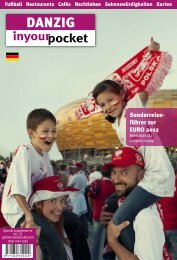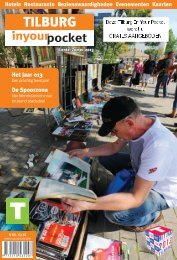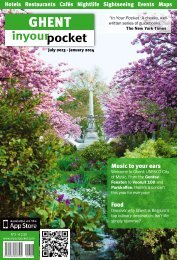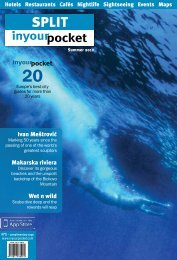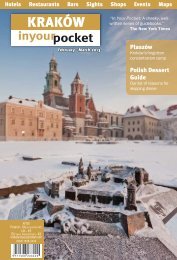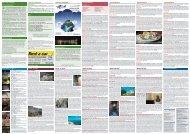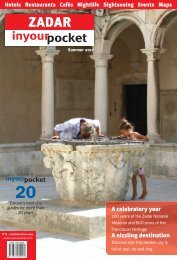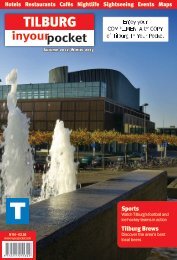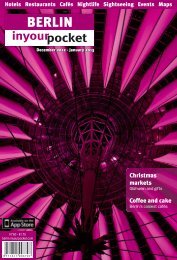7kh 7ul flw\ v prvw dxwkhqwlf 7h[ 0h[ uhvwdxudqw ... - In Your Pocket
7kh 7ul flw\ v prvw dxwkhqwlf 7h[ 0h[ uhvwdxudqw ... - In Your Pocket
7kh 7ul flw\ v prvw dxwkhqwlf 7h[ 0h[ uhvwdxudqw ... - In Your Pocket
Create successful ePaper yourself
Turn your PDF publications into a flip-book with our unique Google optimized e-Paper software.
72<br />
GDAŃSK OLIWA<br />
Edward O’Rourke<br />
One curious connection between Gdansk/Danzig and Ireland<br />
is the fact that the city’s first Roman Catholic bishop<br />
was Count Edward O’Rourke. A Russian of Irish ancestry he<br />
was descended from a branch of the O’Rourke family which<br />
had been forced emigrate to the European continent during<br />
the 17th century. With several generations of O’Rourke’s<br />
having achieved great success fighting in the French and<br />
Russian armies, they eventually settled down on a large<br />
landed estate in what is now Belarus.<br />
Future bishop Edward O’Rourke was born in 1876 and grew<br />
up on the family estate and having attended a Jesuit boarding<br />
school, he studied Economics and Theology at <strong>In</strong>nsbruck<br />
University in Austria. Ordained in Kaunas in 1907, he rose<br />
quickly in the Church, becoming Bishop of Riga in 1918. Following<br />
the extensive redrawing of Europe’s borders after the<br />
First World War, O’Rourke was sent on a special mission to<br />
the newly-founded Baltic States in 1920. Two years later, he<br />
took up the post of ‘apostolic administrator’ (quasi-bishop)<br />
in the Free City of Danzig (Gdańsk) where he would remain<br />
for the next fifteen years. <strong>In</strong> 1925, as a separate political<br />
entity, the Free City was given its own diocese with its seat<br />
in Oliwa cathedral with O’Rourke becoming its first Roman<br />
Catholic bishop.<br />
When the Danzig Nazi Party took control of the Senate in<br />
1933, O’Rourke became one of the strongest allies of the<br />
Polish community in Danzig. With the Church now facing<br />
persecution by an external enemy, internal ethnic divisions<br />
in were set aside and the attitude of Bishop O’Rourke and<br />
part of the German-speaking clergy became more favourable<br />
towards the Polish community. Along with Irishman<br />
Sean Lester, the League of Nations’ High Commissioner<br />
in Danzig, O’Rourke was one of the very few independent<br />
voices prepared to publically criticize Nazi policies in the<br />
Free City. Of particular concern to O’Rourke were attempts<br />
by the Nazi Senate to absorb Catholic youth organizations<br />
and charities into Nazi structures and its pressure to<br />
completely ‘nationalize’ the Church in Danzig.<br />
Despite the fact that Sean Lester was a Protestant and they<br />
initially had no common language except French, the two men<br />
became close friends and political allies. Both considered<br />
personae non grata by the Danzig Nazis, O’Rourke and<br />
Lester found a common affinity in their respect for human<br />
rights, their opposition to Nazism and their Irishness. <strong>In</strong>deed,<br />
O’Rourke was intensely proud of his Irish ancestry, with Lester<br />
recalling in his diary how on their first meeting in 1934 the<br />
bishop came into the room ostentatiously carrying an Irish<br />
magazine and patriotically forcing himself to smoke ‘Irish’<br />
cigarettes over his preferred Russian brand.<br />
Once, however, Lester had been forced from his post in<br />
February 1937, O’Rourke’s became the last independent<br />
voice left in the so-called ‘Free’ City. With a section of the<br />
German-speaking Catholic clergy, along with the Nazis,<br />
openly opposing his support for the foundation of a Polish<br />
parish, O’Rourke finally resigned in October 1937, and moved<br />
to the Polish city of Poznan. <strong>In</strong> 1939 he renounced his Danzig<br />
citizenship and became a Polish citizen before fleeing to<br />
Rome at the outbreak of the Second World War. Although<br />
O’Rourke died in Rome in 1943, in recognition of his defence<br />
of the Free City’s Polish community during the Nazi period, his<br />
bones were reinterred in Gdansk Oliva Cathedral in 1972 and<br />
a plaque can be viewed there commemorating the event. <strong>In</strong><br />
fact, along with Sean Lester who had a plaque unveiled in his<br />
honour by Gdansk City Council in 2010, Gdansk is unique its<br />
commemoration of two men with Irish blood in their veins who<br />
stood up for the human rights of all of the Free City’s citizens<br />
in the face of Nazi totalitarian aggression.<br />
Some 5km northwest of city centre, the sleepy Gdańsk<br />
suburb of Oliwa began life as a small Slavic-Pomeranian<br />
settlement that grew around a Cistercian monastery established<br />
in the latter half of the 12th century. After a long<br />
period as a religious centre and a few catastrophes along<br />
the way including substantial devastation caused by the<br />
Swedes in 1626 and again in 1656 , Oliwa settled down to a<br />
peaceful and prosperous life, becoming an independent city<br />
from 1874 until 1926. Escaping major damage during WWII,<br />
today’s Oliwa is home to around 20,000 people as well as a<br />
number of beasts living in the city’s superb zoo, is the proud<br />
owner of one of Gdańsk’s best parks, boasts a couple of<br />
wonderful museums and offers visitors a charmingly bucolic<br />
and distinctively different excursion.<br />
Getting there<br />
The easiest way to get to Oliwa from Gdansk is to take tram<br />
11 from the main train station. The Tri-City train (kolejka) runs<br />
from Gdańsk Główny station and stops at Gdańsk Oliwa. Oliwa<br />
can be reached by car in about 20 minutes from central Gdańsk.<br />
What to See<br />
Ethnographic Museum (Muzeum Etnograficzne)<br />
E-1, ul. Cystersów 19 (Oliwa Park), tel. (+48) 58 552 12<br />
71 ext. 101, www.muzeum.narodowe.gda.pl. Located<br />
inside the 18th-century Abbatial Granary inside Oliwa Park,<br />
this delightful little diversion features three floors showcasing<br />
all manner of folk-related artifacts from Eastern Pomerania<br />
and is considered to be one of the best collections of its kind<br />
in Poland. Exhibits include a wide range of folk art from wood<br />
carvings to some really amazing paintings made between<br />
the 18th and the early 20th century as well as folk furniture,<br />
displays of traditional fishing implements and other oddities.<br />
Explanations are in Polish only and there are no guide books<br />
for sale, but the museum is such a treat that you hardly notice<br />
this at all. Highly recommended. Q Open 10:00 - 17:00. Closed<br />
Mon. From June open 10:00 - 17:00, Tue 12:00 - 19:00. Closed<br />
Mon. Last entrance 45 minutes before closing. Admission<br />
8/4zł, family ticket 15zł. Fri free for permanent exhibitions. Y<br />
Kuźnia Wodna ul. Bytowska 1a (Oliwa), tel. (+48) 58<br />
552 51 51, www.kuzniawodna.eu. A former water mill whose<br />
interiors now reveal the secrets of making metal. Also open for<br />
musical evenings and events. Q Open 09:00 - 16:00, Sat 11:00 -<br />
17:00, Sun 11:00 - 18:00. Admission 6/3zł, party ticket 15zł. Y<br />
Museum of Modern Art (Odział Sztuki Nowoczesnej<br />
Muzeum Narodowego w Gdańsku) E-1, ul.<br />
Cystersów 18 (Oliwa Park), tel. (+48) 58 552 12 71 ext.<br />
124, www.muzeum.narodowe.gda.pl. <strong>In</strong>side the superb<br />
Pałac Opatów, of which the oldest parts date back to the 15th<br />
century but which owes its present look to a splendid Rococo<br />
overhaul in the mid-18th century, the Contemporary Art Museum<br />
houses works by more than 140 post-WWII Polish artists<br />
as well as putting on the occasional temporary show. Q Open<br />
10:00 - 17:00. Closed Mon. From June open 10:00 - 17:00, Tue<br />
12:00 - 19:00. Closed Mon. Last entrance 45 minutes before<br />
closing. Admission 10/6zł, family ticket 18zł. Groups over 15<br />
people 6zł per person. Fri free for permanent exhibitions. Y<br />
Oliwa Cathedral (Katedra Oliwska) E-1, ul. Biskupa<br />
Edmunda Nowickiego 5, tel. (+48) 58 552 47 65, www.<br />
archikatedraoliwa.pl. Oliwa’s towering Cathedral taking pride<br />
of place at the western end of Oliwa Park was originally built<br />
as a simple wooden structure in the 12th century, and it was<br />
only in 1224 that the brickwork was added. The year 1350<br />
saw a half-wit kitchen boy accidentally start a fire that engulfed<br />
the whole building. Reconstruction began immediately, but in<br />
Gdańsk <strong>In</strong> <strong>Your</strong> <strong>Pocket</strong> gdansk.inyourpocket.com<br />
1626 the building was again destroyed, this time by marauding<br />
Swedish soldiers. Not content with stealing its bells, altars and<br />
valuables, the Swedes kidnapped Oliwa’s hapless monks for good<br />
measure and in a twist of irony, it was in this very building that<br />
Poland and Sweden finally put the past behind them and signed<br />
a peace treaty in 1660. Built along a classic three-aisle design<br />
with a vaulted basilica and shaped in the form of the Latin cross,<br />
today’s interior is dominated by the extraordinary organ over<br />
the main entrance. Built between 1755 and 1780 by the organ<br />
master Johann Wulf, and at the time the largest organ of its type<br />
in Europe, it features moving cherubs, trumpet-playing angels and<br />
comes with a staggering 7,896 pipes and 110 registers allowing<br />
for an incredible range of pitch and sounds including rippling water,<br />
animal cries and human voices; hear it for yourself at the hours<br />
listed. A couple of other points of note are the memorial plague<br />
to inter-war Danzig bishop Edward O’Rourke found on the wall to<br />
the right as you enter from the main entrance and, at the other<br />
end of the church, a strange and beautiful canopy around the high<br />
altar, covered with stars and featuring 150 angels poking out of a<br />
mass of clouds. QOpen 09:00 - 17:00, Sat 09:00 - 13:30, Sun<br />
14:00 - 17:00. Organ performances are at the following times.<br />
May: Mon-Sat 10:00 - 13:00 (every hour), Sun 15:00 and 16:00.<br />
June: Mon-Fri 10:00 - 16:00 (every hour apart from 14:00),<br />
Sat 10:00 - 15:00 (every hour), Sun 15:00 - 17:00 (every hour).<br />
July & August: Mon-Fri 10:00 - 17:00 (every hour apart from<br />
14:00), Sat 10:00 - 15:00 (every hour), Sun 15:00 - 17:00 (every<br />
hour). Admission free unless visiting during a virtuoso organ<br />
performance (entry 4.50/2.50zl).<br />
Oliwa Park (Park Oliwski) E-2, ul. Opacka 12, tel. (+48)<br />
58 552 17 50. The exact origins of Oliwa’s delightful 10-hectare<br />
park are lost to time, but what is known is that Oliwa’s last<br />
Cistercian abbot, Jacek Rybiński (1701-1782) had the gardener<br />
Kazimierz Dębiński originate the beginnings of its contemporary<br />
appearance by designing a French Rococo part of the garden,<br />
still in existence today in the south of the park. After Rybiński’s<br />
death a family by the name of Hohenzollern-Hechingen took<br />
over the park, introducing even more grand designs, and over<br />
the years, and in the hands of several different people, Oliwa<br />
Park gradually took on its modern look, with the addition of a<br />
Chinese garden, English touches, a botanical gardens (closed<br />
in winter) and palm house. Today’s park is a hugely popular<br />
place for people to come and relax, picnic and enjoy the many<br />
sights it has on offer. A fun attraction are the so-called Whispering<br />
Caves (aka. Dionysus’ Ears) to the southeast of the Pałac<br />
Opatów. Assuming that nobody has relieved themselves here<br />
for a while, it’s possible for two people to stand in each ‘ear’ and<br />
have a conversation in the quietest of whispers. A dispute with<br />
Oliwa’s monks seems to have been settled meaning residents<br />
and visitors can continue to look forward to enjoying the park.<br />
Q Park open 05:00 - 23:00. Palm House and Botanical Gardens<br />
open 09:00 - 17:00. Admission free.<br />
gdansk.inyourpocket.com<br />
GDAŃSK OLIWA<br />
May - July 2012<br />
73



